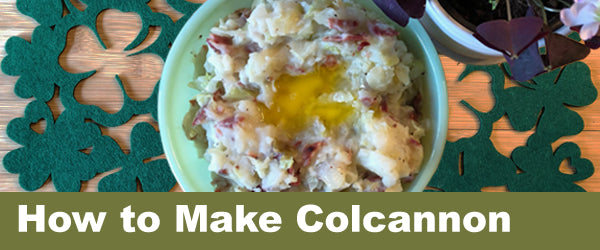
Posted by The Home School in the Woods Team on
Every culture has its unique superstitions when it comes to finding marriage.
For Armenian weddings, the bride takes her veil and circles it over her singles friends’ heads for luck in finding marriage. For Americans, if a single woman catches the bride’s bouquet at a wedding, she is considered to be the next to marry.
However, when it comes to the Irish – they have a special dish called colcannon. Although this cabbage and potato dish is now considered a traditional St. Patrick’s Day food, the truth is, it was originally used for the foretelling of marriages on Halloween!
Keep on reading to learn more about the history behind colcannon. Plus, get our colcannon recipe found in our History of Holidays study.
What Is Colcannon?
The definition of colcannon comes from the Gaelic term “cal ceannann,” meaning “white-headed cabbage.” This side dish is made up of ingredients traditional to Ireland (you guessed it – cabbage and potatoes!).
These two main ingredients are blended with milk into a smooth mash. It’s then topped with a generous glop of butter and bits of salty bacon. The result is a delicious, hearty meal that can satisfy a hard worker’s stomach for hours.
Traditionally, the mash contained charms that were wrapped up and hidden inside. These charms typically included things like thimbles, coins, and rings. If a single lad found a charm in their dish, they were considered lucky and were likely to get married by that time next year.
The History of Colcannon
The Irish have a long history with potatoes. They were one of the first few societies that understood that the nutritional value of the potato could save an entire country from starving (i.e., the Irish Potato Famine).
There’s a lot of speculation as to how the first potato ended up in Ireland, since its land never originally grew them. Many believe that Sir Walter Raliegh was the first to plant the first potato in Ireland around the 17th century.
However, according to Smithsonian, this is unlikely, since Raleigh wasn’t alive when the planting supposedly happened. Instead, the potato probably made its way to the island by accident in 1588 when a Spanish armada crashed upon its shore.
Nevertheless, the potato became a main food source among the Irish. People began utilizing it for breakfast, lunch, and dinner – sometimes, even dessert! They were used as a filling in stews, roasts, and of course – colcannon!
Colcannon is said to have originated in the mid-18th century. How it came to be is unclear. However, it was first referenced in a diary entry by Willaim Bulkely on Halloween night in 1735. Bulkely, who traveled from Wales, mentioned “coel callen,” a dish made of mixed boiled cabbage, potatoes, and parsnips served with a shoulder of roasted mutton.
Many don’t realize that Halloween has always been a popular holiday among the Irish. The origin of the holiday can actually be traced back to the celts. Colcannon was not only a tasty dish that people enjoyed on this holiday, but it also served as a fun, fortune-telling marriage game.
An unmarried woman would go blindfolded into a field and pick a head of cabbage. The cook would then mash all the ingredients together and hide in a few small items such as a thimble, button, coin, or even a ring.
If a lad got the serving with a button or a lass got the thimble, he’d remain a bachelor and she’d remain a spinster for a year. If someone got a coin or sixpence, it meant wealth, while the serving with a ring meant marriage.
Irish immigrants would later introduce the dish to the United States. Today in America, you’ll find colcannon typically served on St. Patrick’s Day. Meanwhile, across the pond, colcannon mash is served any time of year, but especially on St. Patrick’s Day and Halloween.
If you’re ever in Ireland, you’re bound to find this delicious dish at most restaurants. It’s also common to see a colcannon recipe proudly printed on sacks of potatoes at a supermarket.
Make Our Colcannon Recipe
We love this historical recipe because it is not only simple to make, but is also a delicious way to get kids to eat their veggies! Whether you’re studying Celtic culture or the history behind holidays like St. Patrick’s Day or Halloween, this is a fun recipe to make.
Ingredients:
- 2-½ lbs of potatoes, peeled and diced
- 6 slices of bacon, cooked & crumbled (reserve drippings)
- ½ cup milk
- 1 large onion, chopped
- ½ small head of cabbage, chopped
- ¼ lb. (1 stick) butter, melted
- Salt and pepper
Directions:
- In a kettle, cover potatoes with water and boil for 15-20 minutes or until soft
- In a large skillet, heat bacon drippings and saute onion and cabbage at medium heat until translucent (covering the lid can help speed up the process)
- Drain cooked potatoes and mash with milk
- Season to taste with salt and pepper
- Add bacon, onions, and cabbage to potatoes and serve in a large bowl
- Create a well in the center and pour in the butter
Will You Try Irish Colcannon?
Did you enjoy learning the history of colcannon? Do you plan to make it with your kiddos? Tell us in the comments below! And if you’d like to receive more historical recipes in your inbox, sign up for our newsletter on the bottom of our homepage!

Hi, Joanne! Thank you for the heads up on this! We fixed the text above—it is 1/4 lb. (1 stick). …but if you made it with more butter, that’s not a problem! Butter is always better in this recipe… ;-)
Looks great. Quick question. How much butter? 1/4 ?
Thank you for the history lesson, this will be a new Halloween tradition for us, plus a cold winter dinner too!